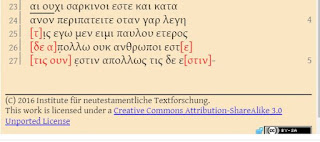Looking at the variation in 1 Cor 3:5 I notice that NA28 lists P46 in support of the first τις as P46vid (from videtur), that is, it is the 'apparent reading, but not certain'.
So how much of τις should be visible in order to warrant this citation?
The image and transcription are actually very clear: There is not a single trace left of any of the letters of τις.
However, the second τις in the parallel question in 1 Cor 3:5 is there very clearly later in the final line. So on the assumption that the scribe of P46 was just as consistent as everybody else who copied this verse, it is not unreasonable to assume that P46 had at one stage τις ουν at the place where we now only have a gap. Still, it seems to me that this is pushing the normal use of 'vid' somehow.
A forum for people with knowledge of the Bible in its original languages to discuss its manuscripts and textual history from the perspective of historic evangelical theology.
- Contributors
- Peter M. Head (ed)
- Tommy Wasserman (ed)
- P. J. Williams, and others


Dirk, I suppose it all depends on how videtur is defined. As NA27/28 says:
ReplyDelete"The sign vid always indicates a high degree of probability, usually based on some surviving letters or parts of letters. When an inference is drawn from the extent of a lacuna, it is carefully verified that the manuscript cannot be cited equally well for other readings in the tradition."
So obviously "inferences are drawn" where no letter or even portion of a letter occurs; plus, in this instance, it appears that the "careful verification" obviously considered the use of τις in the remainder of the immediate context in p46 as opposed to the τι reading that appears in several other MSS.
Given these parameters, there wuld seem to be no real issue with vid as defined.
If we take your citation as definition for the moment, then 1) our current example is not a usual case as it is not based on some surviving letters or part of letters, and 2) neither is it 'an inference drawn from the extent of a lacuna'. So we have to assume that the sign vid also covers inferences based on other considerations not indicated in the definition.
DeleteThe difference is that both with partial letters and inferences based on the extent of a lacuna the justification for the videtur is based on the physical aspects of the manuscript, the remaining traces of ink or the size of the gap.
However, in our example it seems that the argument for vid is not physical but textual, namely the parallel in the question immediately following. And that is where I believe that the pushing of videtur in the apparatus is taking place. I think I'd rather see it restricted to things that one only can get from a close inspection of the manuscript.
I agree though that it is a reasonable conclusion that P46 will have read τις.
Dirk,
DeleteI agree. It appears more likely that the editors based their 'vid' designation on 'what seems to be reasonable' rather than either of the other options listed.
As an aside, I was surprised that the 'vid' designation was used when no portion of a letter was visible. This could easily be my lack of precision in how 'vid' has been previously used.
Tim
In the present case, the "inference ... drawn from the extent of a lacuna" should hold, assuming a general identity of size of the missing letters, particularly at the beginning of a line. Such at least such appears to be the case from my own measured estimate.
DeleteP46, the Ann Arbor part anyway, used to be stored upright instead of flat. I managed to talk them out of it back in the 80's, and they are now stored flat, but damage was done. The papyrus is very thin, and there has been deterioration over the years as a result. The b/w photo negative they have at Michigan taken in the 30's should show the original condition. Other readings have been lost as well.
ReplyDelete